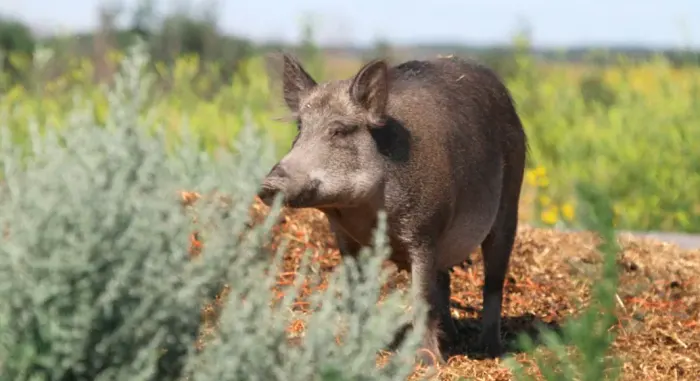
Feral pigs may outsmart Alberta's new bounty hunters, boar expert warns
An open hunt intended to eradicate Alberta's wild boar population may instead make the feral swine more elusive to bounty hunters, a researcher warns.
The province has placed a price on the heads of wild pigs — re-establishing a bounty program designed to root out stubborn populations of the invasive species.
The hunt must be carefully managed, said Ryan Brook, an associate professor in the agriculture department of the University of Saskatchewan and director of the Canada Wild Pig Research Project.
Sporadic hunting will make the animals harder to track, Brook said. Wild boar quickly learn to disperse and evade threats — and will pass these tricks onto their young.
"Wild pigs are incredibly smart, incredibly elusive," Brook said.
"The more pressure you put on them from chasing them or shooting at them — any kind of thing that puts pressure on them and makes them nervous — they will become more and more nocturnal to the point where they may be only active during total darkness."
The province announced Tuesday that hunters, landowners and government-approved trappers will be rewarded for killing boars.
Trappers will be awarded $75 per set of ears, with the expectation that they have killed an entire sounder. Hunters and landowners will also get $75 per set.
The hunting bounty is a pilot program that began April 1 and will run for the next year. To date, the County of Stettler and the Municipal District of Peace have signed on.
The trapper side of the program will run until the spring of 2024.
The Wild Boar Control Program includes expanded surveillance and new compensation for farmers.
Wild pigs are destructive and adaptable. Droves of them have been spotted across North America. (Submitted by Ryan Brook)
Brook said there is no silver bullet to eradicate the prolific breeders. Increased surveillance along with trapping efforts will likely be most effective, he said.
"One of the things that stands out really positively for the Alberta program is it recognizes that there's no one tool to fix this," he said. "There's no one magic option that's going to remove them.
"I do have some reservations about bounties, but I hesitate to be too critical because anytime anybody is doing things to find and remove pigs on the landscape is a very good thing."
Alberta has been waging a decades-long battle against the pigs, which have been spotted in at least 28 municipalities.
RUNNING AMOK
Wild boar's ability to survive in almost any climate makes them among the most prolific invasive species in North America.
A hybrid of domestic pigs and European wild boar, the animals can weigh up to 150 kilograms, and have a woolly undercoat that protects them from the cold.
They usually live in the forest, emerging to devour crops, contaminate water sources and harass livestock. They also carry diseases that can be transmitted to domestic pigs.
They have been found in at least 39 states, with populations entrenched in Alberta, Saskatchewan and Manitoba with scattered infestations in B.C., Ontario and Quebec.
One of the largest feral populations can be found in Texas where bounties have been in place for years.
Boar are very clever and hunting them too heavily in one area can just drive them into new territory, said Allen Williams, owner of Dos Plumas Hunting Ranch, a hog hunting ranch northwest of Abilene.
"If you put enough pressure on them, they'll just find another place to go that's impenetrable."
The animals are clever, incredibly hardy, and will eat almost anything, he said.
"They can adapt to anything," Williams said. "They can make a living on anything. They can eat a rock and make a living off it, I think."
Wild boar were first introduced to Alberta in the 1970s and 1980s for breeding and game farming.
In those early days, the hogs were often allowed to roam at large. Few believed feral pigs could survive Alberta winters. Instead, escapees thrived.

Brook said to reduce wild boar populations, the province will need to combine strategies as hunting alone will be ineffective. (Submitted by Ryan Brook)
THE OLD YELLER EFFECT
In May 2008, as the pigs began to destroy crops with greater frequency, the province declared them an official pest and launched a bounty program, offering Albertans $50 per pig.
More than 1,000 wild boars were killed through the program but it was shut down in 2017, in part due to declining interest.
Williams expects Alberta hunters will be keen to rejoin Albera's bounty hunt.
He said there is a certain mystique about the animals, which he credits to a scene in the Disney film Old Yeller when a young farming boy is attacked by wild hogs.
"That created in everybody's mind, at such a young age, that these things are just out to kill anything that walks by," he said.
"That sense of excitement, that a bit of danger, if you will, is a fixation."
This article was written for the CBC by Wallis Snowden.









